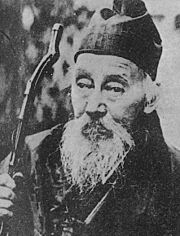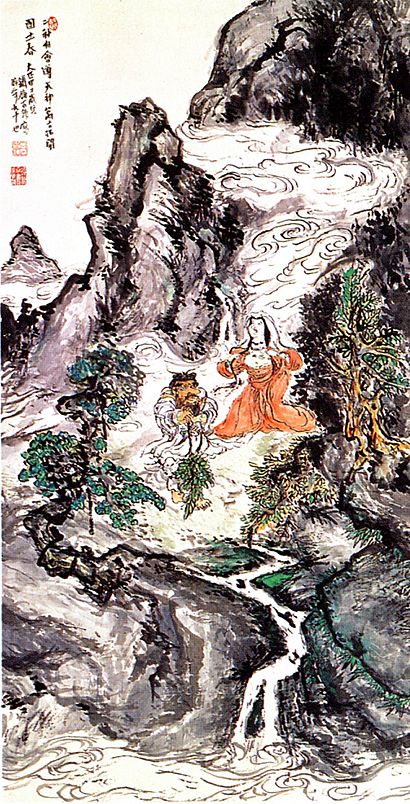Tomioka Tessai facts for kids
Quick facts for kids
Tomioka Tessai
|
|
|---|---|

Tomioka Tessai
|
|
| Born |
Tomioka Yusuke, Tomioka Hyakuren
January 25, 1836 or January 27, 1837 |
| Died | December 31, 1924 (aged 87) |
| Nationality | Japanese |
| Known for | Painter, calligrapher |
| Movement | Bunjinga, Nihonga |
Tomioka Tessai (富岡 鉄斎, 25 January 1836 or 27 January 1837 – 31 December 1924) was a famous Japanese painter and calligrapher. He used the art-name Tessai. He is known as the last important artist in the Bunjinga style. This was a type of painting done by scholars. He was also one of the first major artists in the Nihonga style, which is a modern Japanese painting style. His real name was Yusuke, but he later changed it to Hyakuren.
Contents
A Young Artist's Life
Tessai was born in Kyoto, Japan, in either 1836 or 1837. He was the second son of Tomioka Korenobu, who sold special robes for religious ceremonies. Tessai had trouble hearing, so his parents decided he should become a scholar instead of a merchant.
He studied classical Chinese philosophy and literature. He also learned about ancient Japanese writings from a famous scholar named Okuni Tadamasa. This scholar taught a subject called kokugaku, which means "study of Japanese classics."
In 1843, when Tessai was only seven, his father passed away. His family faced financial difficulties. Young Tessai then became a helper at a Shinto shrine. About twelve years later, he went to live with Ōtagaki Rengetsu. She was a well-known Buddhist poet and nun. She became a very important teacher and supporter for him. Over the next ten years, Tessai developed his own unique art style. He learned from many skilled painters.
Teaching and Traveling
In 1861, Tessai started his own private school. He taught painting from Rengetsu's house. Later, in 1868, he became a teacher at the new Ritsumeikan University. He also worked for the new Meiji government. He helped by creating maps and charts of the land.
During the Meiji period, Tessai traveled a lot across Japan. He visited many famous and beautiful places. These places later became the subjects of his paintings. He saw many different parts of the country, from Nagasaki to Hokkaidō. He also worked as a Shinto priest at different shrines. However, he eventually left his last job as a priest. This was so he could take care of his mother after his brother died.
Art Styles and Influences
After settling back in Kyoto in 1882, Tessai strongly supported old Japanese painting styles. He was against the growing popularity of Western art, known as yōga. Because of this, he was an important part of the early nihonga movement.
Tessai's early paintings followed the bunjinga styles from the early 1800s. But he also tried almost all the art styles popular in Kyoto. These included Rimpa, Yamato-e, and Otsu-e.
However, his main style later became Nanga. This was a Chinese-style painting based on artists from the late Ming dynasty. These styles were brought to Japan by Sakaki Hyakusen. Tessai often used rich, bright colors in his landscape paintings. He showed people in these landscapes, telling a story from history or literature. Sometimes, he used religious images. He would combine Buddhist figures with Daoist or Confucian figures. This showed the idea that Asian religious traditions are connected. Tessai's last works either used very bright colors or were black ink paintings. These ink paintings had thick, rough brushstrokes with small, bright touches of color.
| Two Divinities Dancing | |
|---|---|
| Japanese: 二神会舞図 | |
 |
|
| Artist | Tomioka Tessai |
| Year | 1924 |
| Type | Nihonga watercolor on silk |
| Dimensions | 169 cm × 86 cm (67 in × 34 in) |
| Location | Tokyo National Museum, Tokyo |
Later Life and Achievements
In the 1890s, Tessai became a judge for the Young Men's Society of Painting. Soon after, he became a professor at the Kyoto Fine Arts School. He also helped start several other art groups, like the Nanga Association of Japan. His mother passed away in 1895. Tessai remained close with his family and later had a granddaughter.
In 1907, he was named the official painter to Emperor Meiji. The Emperor liked his work so much that Tessai's job was extended. In 1917, he became a court painter for the Imperial Household Agency. In 1919, he was also made a member of the Imperial Fine Arts Academy.
Throughout his life, Tessai was a Shinto priest and a scholar. He was a very productive painter. It's thought that he painted about 20,000 works during his career. Once, he even finished 70 paintings in a single day! Tessai's best works were created in the last years of his life. These were from when he was 80 until his death in 1924, at the age of 88.
The largest collection of Tessai's art is at the Tessai Memorial Museum. This is a private art museum located at the Kiyoshikojin Seicho-ji, a Buddhist temple in Takarazuka, Hyogo. His art can also be found in many other museums around the world. These include the Princeton University Art Museum, the British Museum, and the Metropolitan Museum of Art.
Important Works
- 「阿倍仲麻呂明州望月図」「円通大師呉門隠栖図 (1914, Important Cultural Property) Hakutaka Museum
- 「二神会舞図」Tokyo National Museum
- 「旧蝦夷風俗図」(1896) Tokyo National Museum
- 「不尽山頂全図」
- 「蓬莱仙境図」
- 「弘法大師像図」
- 「蘇東坡図」
- 「武陵桃源図」 (1923)
- 「瀛洲遷境図」 (1923)
- 「阿倍仲麻呂在唐詠和歌図」Adachi Art Museum
See also
 In Spanish: Tomioka Tessai para niños
In Spanish: Tomioka Tessai para niños

